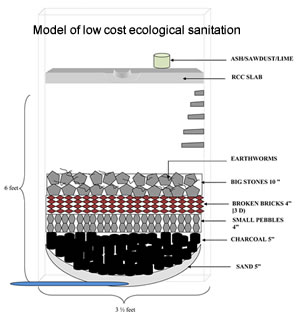Ecological Sanitation
Inadequate sanitation facilities with rising population and declining vegetation cover in most villages have aggravated the problem, especially for women and young girls. Reluctance to construct toilets is largely due lack of awareness and paucity of space in closely settled villages. Those who have constructed the costlier water-based toilets are unable to keep them clean due to scarcity of water. Resultantly the majority of members prefer going out in the open. The concerns regarding high cost of construction and availability of water and carrying it on a daily basis is yet another reason why sanitation facilities elude the majority of households in remote and far flung villages.
Composting toilets in the mountain region is a suitable option, especially in remote areas where traditional sewer line or septic tanks construction is not possible or very costly. These toilets use little or no water, do not stink and once properly made can last for 8 to 10 years for a family of six. Under this intervention two different models will be promoted with location specific modification. Presently the combined processing model is being constructed on a pilot scale.
It is well recognized that any compost toilet programme also requires an education intervention in order to ensure that the principles of use and maintenance are clearly understood and accepted by the user group. Therefore awareness generation through serial meetings and onsite training on construction of eco toilets will be integral part of the strategy to ensure wider replication.
Model 1. Combined processing
This composting based eco toilet is modification of old pit where urine and faeces get mixed together. It addresses key concerns like affordability, reliability, hygiene, maintenance. In this model urine and faeces get mixed together and after each use two handfuls of ash/ sawdust is sprinkled over the faeces . The ash absorbs moisture, neutralizes bad odours and makes it less attractive to flies. The charcoal placed above the sand helps in absorbing toxics which cause smell in the urine. The urine and faces in the same pit but separated by layers of stones and pebbles and liquid passes through charcoal that acts as a filter.
The outlet pipe placed at the bottom to drain the excess liquid so that, dryness is maintained inside for easy decomposition. Once a month dry leaves and ferns are thrown into the pit for earthworms to feed on. To absorb excess moisture, a small pit filled with fertile soil is made on the side and saplings of tree species like robinia, wild rose and wild peach can be planted. A simple structure for privacy, made from locally available materials, is then built around the slab.
When the pit is full, left for 2 months to decompose and second pit is put to use. The compost formed in the first pit is removed or emptied and used as fertilizer in the agriculture field. If the toilet is used and maintained properly the waste breaks down to 15-30 per cent of its original volume.


